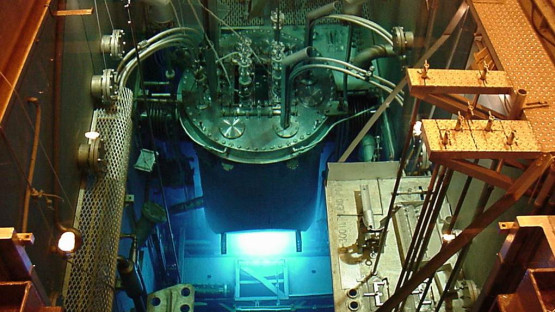
If you would like to learn more about the IAEA’s work, sign up for our weekly updates containing our most important news, multimedia and more.
Supporting African Scientists to Harness the Power of Research Reactors for Socio-economic Development
Omar Yusuf

South Africa’s SAFARI-1 research reactor has been in operation since 1965. It is one of the world’s five largest producers of the medical radioisotope molybdenum-99. (Photo: South African Nuclear Energy Corporation)
The first uranium deposits in Africa were discovered in 1915 in the village of Shinkolobwe, located in the south of today’s Democratic Republic of the Congo. Approximately four decades later, in 1958, Africa’s nuclear science and technology story would begin, with the first criticality of the Democratic Republic of the Congo’s TRICO I research reactor, the first such reactor built in the region, at the University of Kinshasa. Egypt and South Africa followed the Democratic Republic of the Congo’s example soon after, commissioning reactors in 1958 and 1965, respectively. Research reactors have played a vital role in the continent’s socio-economic development ever since.
Africa now has 11 research reactors in 8 countries, namely Algeria, the Democratic Republic of the Congo, Egypt, Ghana, Libya, Morocco, Nigeria and South Africa. These facilities have a thermal power of up to 22 megawatts and are routinely used for numerous applications, including to support sustainable land management among African farmers, to produce radioisotopes for life-saving cancer treatments and for probing the structural integrity of buildings and industrial equipment, and to identify sources of industrial air pollution.
Although around ten African countries are presently considering nuclear power generation, many others consider the deployment of research reactors to be a stepping stone towards future power programmes, since this will enable the build-up of a contingent of trained personnel with relevant capabilities.
Some countries without research reactors — including Ethiopia, Kenya, the Niger, Rwanda, Senegal, Uganda, the United Republic of Tanzania and Zambia — are now considering, or planning for, the construction of research reactor facilities and have already targeted specific applications and products or services for delivery.
Training the next generation of research reactor professionals
The need for radiation services provided by research reactors and, consequently, for young professionals capable of delivering them, has intensified in recent years. As a result, the IAEA is supporting African countries to develop strategic plans for the construction and use of new research reactors.
For example, through an ongoing regional technical cooperation (TC) project, experts from several African countries attended an IAEA workshop in June 2023 to learn how to prepare strategic plans for the construction of new research reactors. These business-facing plans are designed to provide both justification for a facility’s construction and detailed recommendations for use of the reactor, including specific radiation services or products for industrial, medical and scientific use. Under the guidance of IAEA experts, the participating scientists were subsequently asked to propose corresponding financial and policy plans to ensure the safety and sustainability of the proposed research reactor.
Throughout the week-long training workshop, presentations and practical sessions were provided by IAEA specialists to attending scientists from Ethiopia, Kenya, the Niger, Rwanda, Senegal, Uganda, the United Republic of Tanzania and Zambia.
Complementarily, in order to support capacity building in the areas most closely associated with the operation of research reactors, the IAEA launched the IAEA-designated International Centre based on Research Reactor (ICERR) initiative, a scheme which identifies facilities capable of accommodating the training and research needs of countries without routine access to research reactors. In May 2023, the third iteration of the IAEA’s Research Reactor School in the Africa Region was held at the most recently recognized ICERR, Morocco’s National Centre for Nuclear Energy, Sciences and Technology (CNESTEN), which operates the MA-R1 research reactor.
Designed to provide intensive training in reactor physics, as well as the safe operation and utilization of research reactors, the third Research Reactor School in the Africa Region provided the 13 attending engineers and physicists with the opportunity to witness the real-time operation of a research reactor. Specifically, the attendees were able to study how experts at CNESTEN produce medical radioisotopes and conduct neutron activation analysis. “The school was highly educative, informative, engaging and valuable,” said Yahaya Musa, who works in medical physics at the Centre for Energy Research and Training in Zaria, Nigeria. “The programme enhanced my research reactor operation and experiments knowledge and developed my skills in these areas.”
Supporting the safety, operation and utilization of reactors
While newcomer countries are pursuing the development of new research reactor facilities, existing reactors on the African continent could also benefit from improved operational safety standards, more effective business planning, and the closer association of research reactor services with persisting national development challenges.
This is the aim of another ongoing IAEA TC project — channelled through the African Regional Cooperative Agreement for Research, Development and Training related to Nuclear Science and Technology (AFRA) — that is prioritizing the improved safety and strategic operation of Africa’s fleet of research reactors. From the preparation of safety documents to the implementation of periodic safety reviews and emergency preparedness arrangements, scientific visits have helped the project’s participating countries — all of which presently operate research reactors — to identify how best to improve their compliance with the relevant IAEA safety standards and guidance.
Senior African scientists have also visited research reactor institutions in the Czech Republic, France, Germany, Jamaica, Malaysia, the Netherlands and Thailand to observe and study how their counterparts abroad apply the IAEA’s safety standards, ageing management guidance and utilization programmes at their facilities. These site visits and knowledge exchanges are aimed at enhancing regional capacities; improving the utilization of research reactors for socio-economic development and ensuring their operational safety.



